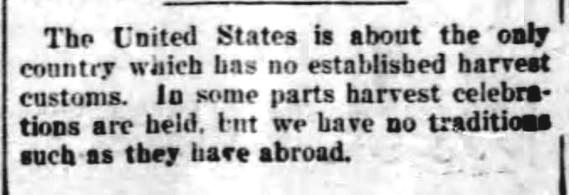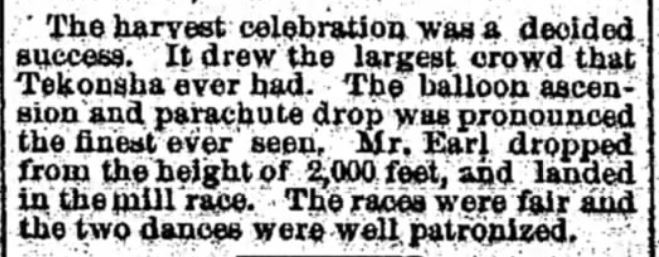Victorian America’s Harvest Celebrations
Victorian America’s Harvest Celebrations
.

.
The United States may have been (according to The Gazette of York, Pennsylvania, on December 29, 1899) “the only country which has no established harvest customs. In some parts harvest celebrations are held, but we have no traditions such as they have abroad.”
.

The Gazette of York, Pennsylvania on December 29, 1899.
.
In 1884, an announcement published in Bismarck Weekly Tribune indicates that community hadn’t yet made a traditional event of their own. Local farmers had expressed a wish to indulge in a harvest festival. When? Where? What time? In the city? On a farm? ….once the rush and hurry of the harvest was over, of course.
.

Bismarck Weekly Tribune of Bismarck, North Dakota on August 8, 1884.
.
Victorian America’s communities enjoyed “Harvest Celebrations” and events were reported in newspapers. Here are several, ordered oldest to newest.
.
Actually, harvest celebrations were a big deal. Chiefly, this late-season event served as one last chance to socialize with neighbors before winter limited travel.
My Thanksgiving-themed novel, Unmistakably Yours, includes a harvest celebration.
.
.

.
It makes perfect sense that America’s European immigrants would continue harvest traditions of their homelands. Take careful note of the use of the term “katzenjammer.” Sounds German… but what does it mean?
.

Buffalo Morning Express of Buffalo, New York on September 3, 1874.
.
Katzenjammer?
.
Katzenjammer is a colorful noun borrowed from German, no doubt from German Immigrants. The term refers to the confusion and uproar of cats in distress. Also applies to “a severe headache resulting from a hangover.” ~ Google (see image, below)
.
Here, the charming part:
.
“The term was popularized by the cartoon Katzenjammer Kids, drawn by Rudolf Dirks (1877 – 1968) in 1897 for the New York Journal, featuring two incorrigible children.”
Note: a documented reference of 19th century use of “kids!”
.

Definition of katzenjammer, also use of the term over time. Courtesy of Google.
.

Photocopy of a Katzenjammer Kids comic published in the New York Journal on Sunday, December 17, 1897. Image courtesy of oocities.
.

Essex County Herald of Guildhall, Vermont on July 31, 1875.
.

.

1 of 4: Harvest Home Celebrations. Reading Times of Reading, Pennsylvania on August 4, 1877.

2 of 4: Harvest Home Celebrations. Reading Times of Reading, Pennsylvania on August 4, 1877.

3 of 4: Harvest Home Celebrations. Reading Times of Reading, Pennsylvania on August 4, 1877.

4 of 4: Harvest Home Celebrations. Reading Times of Reading, Pennsylvania on August 4, 1877.
.
Crops of virtually all kinds yielded beautifully in 1877–reasonable prices, plenty for all, and anticipation of a winter with plenty to eat. Within a couple of years, a decade began of deprivation and hunger. Harsh winters began early and ended late, wherein many people suffered greatly. See my post on Victorian Blizzards, Nonstop in the 1880s.
.

.

The Daily Chronicle of Centralia, Washington on August 3, 1898.
.
The Program for Season of 1898, in Lincoln Park, Bakerville ws reported in The Marshfield News and Wisconsin Hub) of Marshfield, Wisconsin on September 8, 1898. This notice must have been published from summer on, at least a few times, as it still includes the Independence Day events and a Picnic on Sunday, July 24th. Further, the notice mentions the annual Schützenfest held on Sunday, September 4, Day and evening–though republished a few days thereafter.
Most importantly, the ad includes “Harvest Celebration” to be held Sunday, August 15. This particular example included celebrating day and evening.
Perhaps having the notice set in type, again, would cost more than leaving it be.
.

The Marshfield News and Wisconsin Hub of Marshfield, Wisconsin on September 8, 1898.
.
Schützenfest?
.
Schützenfest, translated as the Marksmen’s Fest, is a traditional German festival dating back to medieval times. It celebrates a marksman saving a young child’s life from an eagle attack.
.
Schützenfest was brought to Cincinnati in 1866 by German immigrants.
.
.

.
The Salvation Army held celebrations of “Thanksgiving at Harvest Time,” “For Year of Plenty.” Note the subheading: “Rich and Poor Alike to Be Asked to Bring Their Gifts to the Altar of Praise–Large Amounts Raised in This Way for Benevolent Purposes.”
.

1 of 2: The Rock Island Argus and Daily Union of Rock Island, Illinois on September 27, 1899.

2 of 2: The Rock Island Argus and Daily Union of Rock Island, Illinois on September 27, 1899.
.
The Salvation Army held a different kind of Harvest Celebration, attended by dignitaries in their organization, running from Saturday night until Tuesday evening. Three-day celebrations weren’t unique to The Salvation Army.
The occasion “will begin with a grand march Saturday and an ‘egg meeting,’ when all are expected to bring an egg or eggs to the hall for sale.” As a fund-raiser?
After Saturday and Sunday services “there will be a display of produce which will be sold Monday night.” Another fund raiser?
.

The Evening Review of East Liverpool, Ohio, on September 29, 1899.
.

.
Merchants discounted prices and held SALES during Harvest Celebrations. See this St. Louis, Missouri ad, for example. After all, shopping was a new thing.
.

St. Louis Post-Dispatch of St. Louis, Missouri on October 5, 1899.
.
Harvest customs included “corn huskings.” As an illustration, see the 1890 article, below.
.

The Daily Republican of Monogahela, Pennsylvania on March 31, 1890.
.

The Marshall Statesman of Marshall, Michigan, on August 15, 1890.
.

Green Bay Press-Gazette of Green Bay, Wisconsin, on August 15, 1890.
.
Kirmiss? “Thirty-third Annual Kirmiss, or harvest celebration”:
.
In Europe, particularly in Belgium and Holland, and outdoor festival and fair. In the United States, generally an indoor entertainment and fair combined.
.
.
























